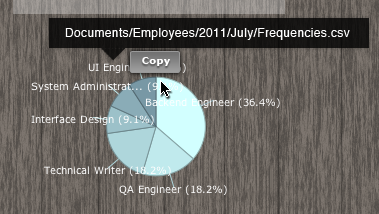I would like to show a path of the data source of an object (diagram with csv-data) and to give the user the option to copy the path to clipboard. I made different approaches.
One idea was if I could use a tooltip which shows the path. Additionally I would add a Copy/Copy to Clipboard-button. That approach doesn't need more different elements than an outline (shown by rollover and activation) and interactions. It needs a simple rollover plus one click for copy to clipboard, but I am not sure if this is against various interface rules.

Here a button inside the tooltip, but I am not sure, what happens if the user leaves the sensitive canvas (diagram) to use to the button. Tooltip is above the Diagram. I assume, it needs technical feedback and special rules for the tooltip behavior. E.g. when will the tooltip disappear if the user roll out with mouse.

My question is, can I mixup a tooltip with an interaction element like a button? I have never seen such case.



